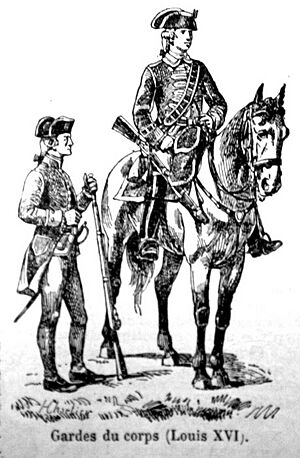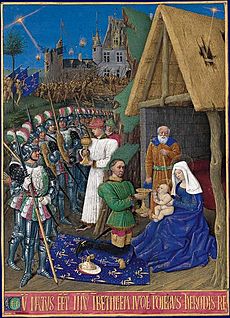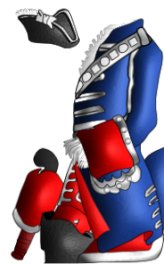Scottish Guards (France) facts for kids

The Scottish Guards (French: Gardes Écossaises) were a special group of bodyguards. They were created in 1418 by Charles VII of France to protect the French kings. They became part of the king's personal household, known as the Maison du Roi. Later, they formed the first company of the Garde du Corps du Roi, which means the Royal Bodyguard.
In 1450, King James II sent 24 Scottish nobles to France. This group was called the archiers du corps or gardes de la manche. By 1490, they became the first company of the king's archers, led by Guillaume Stuier (Stuart). At first, this Scottish company had 100 bodyguards. Each bodyguard had four helpers. One of them was known as the "first man-at-arms of the Kingdom of France." The Scottish Guards were finally ended in 1830 when Charles X gave up his throne.
Contents
History of the Scottish Guards

Early Scottish Fighters in France
Scottish fighters may have served in France as early as the time of Charlemagne. But we have clear proof only after 1295. This was when the Auld Alliance began, a long friendship between Scotland and France.
During the Hundred Years War, Scottish groups officially fought for Philip VI of France. At the Battle of Poitiers in 1356, many Scottish knights fought for John II of France. Later, in the 1360s, Scots also served in the army of Bertrand du Guesclin. In the early 1400s, France was having a civil war. Henry V of England took this chance to invade France. The French prince, the Dauphin, needed allies. He found them in Scotland and Castile.
The Great Scottish Army
In 1418, Robert Stewart, Duke of Albany sent his son, John Stewart, 2nd Earl of Buchan, to lead a large Scottish army to France. This was the biggest army Scotland had ever sent abroad. About 7,000 to 8,000 men arrived in France in 1419. They went to meet the Dauphin, who would become Charles VII. The Dauphin gave gifts and lands to the Scottish nobles.
The Scottish leaders went back to Scotland to get more troops. They returned in 1420 with another 4,000 to 5,000 soldiers. While they were away, the Dauphin chose about 100 of the best Scottish fighters to be his personal bodyguards. These Scots fought bravely in France. They won a big battle at Baugé in 1421. But they suffered a huge loss at the Battle of Verneuil in 1424, losing 6,000 men. Even with these losses, Charles VII continued to honor the Scots who survived.
The Royal Bodyguard's Role

The king always kept his Garde Écossaise close by. They likely protected him during a murder at a bridge in 1442. They also saved him from a fire in Gascony that same year. In 1465, Scottish Guards died defending their king, Louis XI of France, at the Battle of Montlhéry.
Later Years of the Guards
The Garde Écossaise lasted until the end of the Bourbon kings in France. They were the main or Scottish Company of the Gardes du Corps (Body Guards). There were four companies of Body Guards. A group of them always went with the French King. They guarded his sleeping area and even escorted his food from the kitchen.
Over time, more Frenchmen joined the unit, and fewer Scots. But the name "Scottish Guards" stayed, as did some Scottish words used for commands. By the time of Louis XV, the Scottish Company had 21 officers and 330 men. They last fought in 1747, escorting Louis at the Battle of Lauffeld. On this day, they carried claymores, which are Scottish swords. They wore white sashes with silver lace to show they were different from other guards.
The Scottish Company also had a special group of 24 Gardes de la Manche. This means "Guards of the Sleeve." They stood very close to the king during important events. Their name showed they were so close they could be brushed by his sleeve. They wore fancy white and gold coats over their blue, red, and silver uniforms.
When the Guards Were Disbanded
All four companies of the Body Guard were officially ended in 1791. This happened after the royal palace at Versailles was closed in 1789. They were brought back in 1814. Until they were finally ended in 1830, the Scottish Company was still called les fiers Ecossais, meaning 'the proud Scots'.
Famous Guardsmen
- Jean Stuart, earl Darnley (killed in 1429)
- Robert or Robin PetitLoch (1419–1461)
- Christin Chamber knight (1425–1447)
- Patris Folcart (1449–1461)
- Patrick Neiven (killed in 1429)
- Thomas Haliday (1449–1461)
- Patrick de Spens (1450–1485)
- Guillaume Stuyers (1461–1464)
- Thomas Stuyers (1465–1472)
- Robert Coningham (1475–1478)
- Jean de Coningham (1479–1492)
- Berault Stewart or Stuart (1492–1508)
- Godebert (Cordebert Chandeber(t)) Carre (Carr)
- Robert Stewart or Robert Stuart (1470–1543)
- Jacques de Motgommery (1543–1556)
- Gabriel, Count de Montgomery (1530–1574), who accidentally hurt King Henry II in a jousting match.
- Jacques de Montgommery (1555–1561)
- Sir John Hepburn
- Sir Robert Moray
- Charles de La Vieuville
- Robert Sempill
- Sir Donald Cameron (1746-1748)
- Antoine de l'Hoyer (1768–1852)
The Scottish Guards in Stories
- Quentin Durward by Walter Scott
- Bonnie Prince Charlie: A Tale of Fontenoy and Culloden by G. A. Henty
- Queens' Play by Dorothy Dunnett
- La Guarde Ecossaise by Kirsteen M. MacKenzie
See also
- Auld Alliance
- Battle of Culloden, 1746
- Flight of the Wild Geese
- Gallowglass
- Mercenary
- Swiss Guards (French)
- Walloon Guards (Spanish)




